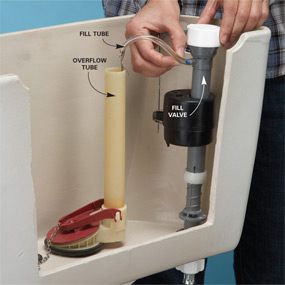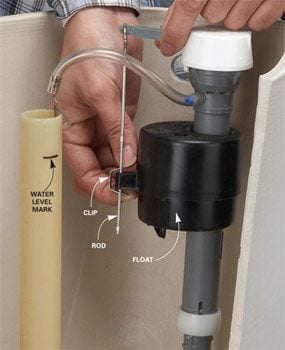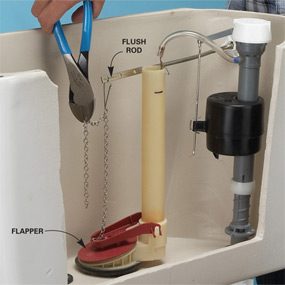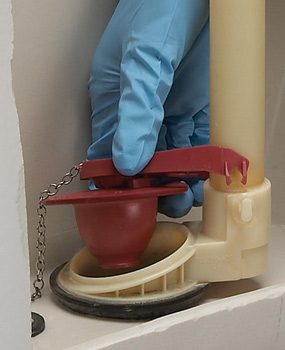Fixing a Toilet That Is Constantly Flushing
Check the fill tube

Overflow tube problem
Push the fill tube firmly onto the fill valve. Make sure the fill tube sends water into the overflow tube.
Remove the tank lid and find the fill tube. It’s a small flexible tube that runs from the fill valve to the overflow tube. While the tank refills, this tube squirts enough water down the overflow tube to refill the bowl after the completed flush. If this tube falls off or the water stream misses the overflow tube, the bowl won’t fill and your next flush will be wimpy (that is, won’t develop a strong siphon). Reattach the fill tube and make sure it perches about 1 in. above the rim of the overflow tube. Flush the toilet and watch the water stream to make sure it goes down the overflow tube.
Adjust the fill height

Check the float
Adjust the float to set the water level. Pinch the clip and slide the float up or down on the rod. Keep adjusting the float until the water shuts off at the proper level.
The water level in the tank is controlled by an adjustable float. A float that’s set too low produces a weak flush; if it’s set too high, water spills into the overflow tube and the fill valve won’t shut off. The water will keep running. Look for the fill level mark on the inside back of the tank and mark it on the overflow tube so you can see it more easily. If you can’t find it, measure down about 1 in. on the overflow tube and make a mark. Then flush the toilet and see if the water reaches and stops at that mark. If not, adjust the float up or down. If you have an old toilet, you’ll have to bend the brass rod that connects to the float ball to make adjustments. But with newer toilets you usually turn a screw or slide a clip along a rod. Flush the toilet after each adjustment.
Also make sure that the water level is at least an inch below the C-L (critical level) marked on the fill valve. You can adjust the height of many valves to raise or lower the C-L.
Occasionally the fill valve simply won’t shut off, which means that it’s defective. If so, turn the water supply off at the shutoff under the tank. Buy a replacement valve (sold at hardware stores and home centers). You don’t have to match the old one; many, like the one shown, fit most toilets. It’s a 15-minute change-out.
Adjust the flush handle/flapper chain

Flapper chain fix
Adjust the chain to leave a little slack with the flapper closed. Then cut off the excess, leaving about an inch.
A chain that’s too short or tangled won’t allow the flapper to close and water will continue to leak into the bowl. This causes the fill valve to cycle on and off to refill the tank. A chain that’s too long, or a flush rod that hits the the tank lid, won’t open the flapper wide enough to stay open for the full flush. You’ll find yourself having to hold the lever to complete a good flush.
To avoid these problems, adjust the linkage in the chain to leave only a slight bit of slack when closed. Cut the chain at the rod to leave only about an inch extra to reduce the potential for tangles. Then put the tank lid back on and make sure the flush rod doesn’t strike the lid when you press the lever. If it does, bend it down slightly and readjust the chain.
Replace the flapper

Change the flapper
Unsnap the old flapper and take it with you to the store to find an exact replacement. In addition to the closest replacement, pick up a “universal” type.
If you’ve completed the first three steps and your toilet still runs, chances are you have a worn-out flapper. Turn off the water, remove the old flapper and take it to the store to find an exact replacement. (Hardware stores often carry a wide variety.) Most flappers snap over ears on the overflow tube. Others have a ring that slips over the tube.
Now here’s the catch. You may not find an exact match. The range of flapper styles has mushroomed over the last 15 years, and you may find 15 to 20 flapper options on the store shelf. Some packages include specific brand and model information (so note yours before you leave home). Others have a “universal” label. If you can’t find an exact replacement, try the closest one and pick up a universal type as well. They’re cheap, and the extra one just might save you a second trip to the store! (Avoid the “adjustable” types unless you’re replacing an adjustable one.)
Install the new flapper and make sure it opens and closes freely. Then test it. If the water continues to run or runs intermittently, you’re not getting a good seal. Try a different flapper.
If you just can’t find a flapper that seals, consider replacing the entire overflow tube/flapper. On most toilets (two-piece), this means removing the tank. It’s not difficult and you don’t need special tools. It’ll take you about an hour, and you’ll avoid that expensive plumber service call.
Required Tools for this Project
Have the necessary tools for this DIY project lined up before you start—you’ll save time and frustration.
- Pliers
You’ll also need cutting pliers and rubber gloves.
Required Materials for this Project
Avoid last-minute shopping trips by having all your materials ready ahead of time. Here’s a list.
- Replacement fill valve
- Toilet flapper